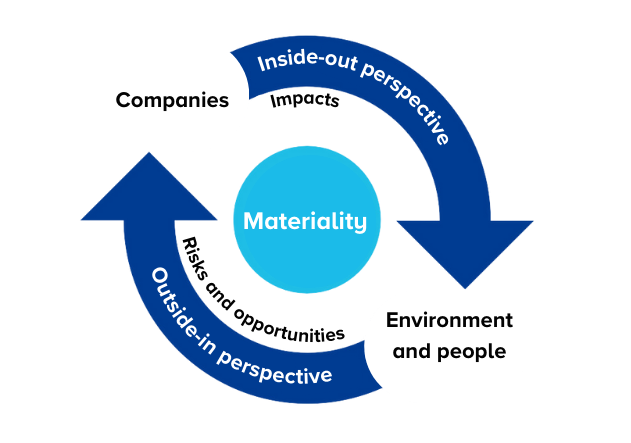
What is a double materiality assessment (DMA)?
The double materiality approach encourages companies to consider both how external sustainability issues affect their business and how their business practices affect the world around them. The concept is used in environmental, social, and governance (ESG) reporting and corporate sustainability. It recognises two dimensions of materiality:
- Financial materiality: This aspect considers how ESG issues affect the financial performance of a company. It focuses on the risks and opportunities that these issues present to the business, such as regulatory changes, reputational risks, and market shifts.
- Environmental and social materiality: This dimension looks at how a company's operations impact the environment and society. It assesses the effects of the company's activities on climate change, biodiversity, human rights, and community well-being, regardless of whether these impacts directly affect the company's financial performance.

This approach is increasingly being adopted in frameworks like the European Union's Corporate Sustainability Reporting Directive (CSRD) and is essential for effective sustainability strategies and transparent reporting.
If a sustainability impact topic is identified as significant, the company is required to report according to the relevant topic-specific European Sustainability Reporting Standards (ESRS) standard.
Purpose of double materiality assessment in CSRD
Under ESRS E1 Climate change, there are nine reporting requirements identified as ESRS E1-1, ESRS E1-2, and so on. To adhere to CSRD standards, including ESRS E1, a company must follow three steps: first, conduct a double materiality assessment (DMA); second, report against the factors identified in the DMA in accordance with the specified reporting requirements; third, arrange for a third-party audit of the report.
Double materiality assessment example
- Preparation: Begin with a business stocktaking phase to assess the current state of the organisation.
- Identification: Analyse the company’s value chain and map stakeholders. This includes upstream, internal, and downstream activities, and identifying key stakeholders.
- Evaluation: Create an ESG long list by identifying and collecting material ESG topics based on stakeholder survey results and other relevant internal and external information. Consider industry-specific requirements and validate findings through interviews with internal experts to ensure completeness.
- DMA Workshop: Focus on financial and impact materiality by determining suitable quantitative and/or qualitative thresholds for evaluation criteria. Conduct a pre-assessment of both negative and positive current and potential impacts on the environment and people from upstream, downstream, and operational activities. Also, assess the financial impact of physical risks, transition risks, and opportunities in the short, medium, and long term.
- Consolidation: Develop a materiality matrix by consolidating findings regarding material impacts, risks, and opportunities from the final materiality assessment. Document the methodology and approach used throughout the process.
The concept of double materiality offers several advantages. It expands sustainability reporting obligations and ensures that material sustainability aspects are covered. This approach involves both internal and external stakeholders, and the findings from the materiality assessment are intended to positively influence the company's actions, helping to establish targets, key performance indicators (KPIs), and measures.
Learn more about climate action with our online academies and deep dives.